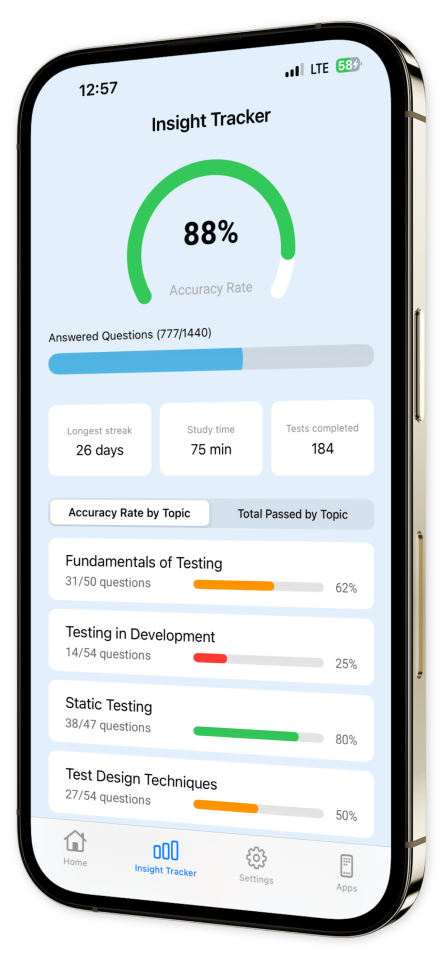

ISTQB Foundation Exam Test iOS and Android App
Achieve your ISTQB Foundation Level certification with ISTQB Foundation Exam Test—the ultimate preparation tool designed for software testers. Whether you're just starting or advancing your career, this app delivers all the resources you need to confidently pass the exam.
Leverage your knowledge of Black-box Testing Techniques, master Risk-based Testing principles, and gain confidence in navigating through the Software Development Life Cycle (SDLC). With expertly designed questions and explanations based on ISTQB’s latest syllabus, you'll be prepared to demonstrate your skills and understanding of key concepts such as Equivalence Partitioning, Boundary Value Analysis, and Static Testing.
Maximize Your Success with Key Features:
Comprehensive Content Mastery: Explore all critical topics, including Fundamentals of Testing, Test Management, and more, expertly curated for thorough exam preparation.
Challenging Practice Questions: Strengthen your understanding with a variety of carefully crafted questions that reflect the exam’s focus on practical application and theoretical knowledge.
Detailed Explanations: Enhance your learning with clear, in-depth explanations for each question, ensuring you grasp the ISTQB-recommended testing practices and principles.
Progress Tracking: Monitor your progress, focus on areas that need improvement, and optimize your study strategy with our built-in tracking tools.
Offline Access: Study seamlessly, anytime and anywhere, even without an internet connection.
Prepare smarter and more efficiently with ISTQB Foundation Exam Test—your essential companion for success in ISTQB certification.
Elevate your testing career and validate your expertise with ISTQB certification. Let ISTQB Foundation Exam Test guide you every step of the way.
Content Overview
Explore a variety of topics covered in the app.
Example questions
Let's look at some sample questions
Which of the following is NOT one of the seven principles of testing?
Exhaustive testing is impossibleEarly testingPesticide paradoxMore testing equals better software
'More testing equals better software' is not one of the seven principles of testing. The seven principles are: Testing shows presence of defects, Exhaustive testing is impossible, Early testing, Defect clustering, Pesticide paradox, Testing is context dependent, Absence-of-errors fallacy.
In Agile, what does 'time-boxed' mean?
The project must be completed within a certain timeframeEach task must take a certain amount of time to completeEach sprint or iteration has a fixed durationThe project schedule is flexible and can be adjusted as needed
In Agile, 'time-boxed' means that each sprint or iteration has a fixed duration.
Which of the following static testing techniques involves a meeting of stakeholders?
WalkthroughInspectionInformal reviewFormal review
Inspection involves a formal meeting of stakeholders, including the author, reviewers, and perhaps a manager or project manager.
What is the main focus of Error Guessing?
To guess where errors can be hidden in the systemTo guess the performance of the systemTo guess the security vulnerabilities in the systemTo guess the usability issues in the system
Error Guessing focuses on guessing where errors can be hidden in the system. It does not focus on guessing performance, security vulnerabilities, or usability issues.
Which of the following is NOT a typical task in test planning?
Defining the scope of testingDesigning test casesDetermining resource requirementsSetting up the test environment
Designing test cases is typically a task in test design, not test planning. The other tasks listed are all typical tasks in test planning.
What does risk exposure in risk-based testing mean?
The likelihood of a risk occurringThe potential impact of a riskThe combination of the likelihood and impact of a riskThe identification of a risk
Risk exposure in risk-based testing is the combination of the likelihood and impact of a risk.
What does a test management tool typically use to relate requirements, test cases, and defects?
EmailTraceability matrixFlowchartGantt chart
A test management tool typically uses a traceability matrix to relate requirements, test cases, and defects.
Which feature of Test Management Tools provides an overview of all testing activities and their status?
DashboardTest case creationTest executionDefect tracking
The 'Dashboard' feature of Test Management Tools provides an overview of all testing activities and their status.
Which tool integration strategy is most suitable for small, simple projects?
File-based integrationMessage-based integrationDatabase integrationNone of the above
For small, simple projects, file-based integration is often the most suitable strategy due to its simplicity and ease of implementation.
Which Tool Integration strategy is best suited for a project with a linear and sequential process?
Horizontal Tool IntegrationVertical Tool IntegrationComposite Tool IntegrationNone of the above
Vertical Tool Integration strategy is best suited for projects with linear and sequential processes as it allows for seamless flow of data and control across different phases of software development.









